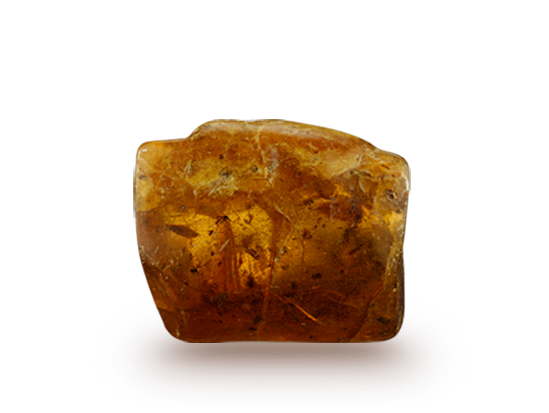OVERVIEW
The Greeks called amber elektron, or “made by the sun.” Homer praised its bright glow. The Egyptians buried it in tombs for the afterlife. Today’s scientists value amber too: it provides a three-dimensional window into prehistoric ecosystems through the myriad animal and plant inclusions it contains.
Amber is an organic gem. Organic gems are the products of living or once-living organisms and biological processes. Amber formed tens of millions of years ago, when sap from ancient trees hardened and fossilized.
Scientists and collectors treasure amber that contains suspended animal or plant fragments. These fossilized bits of once-living things were trapped in the hardening amber, creating a fascinating time capsule.Some types of amber are found in the ground. Other types have been freed and carried by tides, ending up on beaches or near-shore areas. The Baltic coast bordering Germany, Poland, and Russia is still an important source of amber.
Amber is sometimes called “gold of the North.” Its warm luster is featured in beads, carvings, pendants, and cabochons, as well as decorative items like cups, bowls, snuff boxes, and umbrella handles. A related material, called copal, is also fossilized tree resin, but it’s far younger than amber, at less than a million years old.
- Organic, not mineral: Fossilized resin
- Chemistry: C10H16O
- Color: Yellow, orange, and brown
- Refractive index: 1.540
- Specific gravity: 1.08
- Mohs Hardness: 2.0 to 2.5
BIRTHSTONE
While amber isn’t a birthstone, it is associated with the astrological sign of Taurus.
HISTORY
Amber is probably best known for its insect and other types of inclusions. Millions of years ago, when amber oozed from countless plants, the substance acted as a sticky trap for ants, bees, termites, and other insects. Flower parts, leaves, and pine needles are also typical amber inclusions, along with gas bubbles.
Amber containing larger animals like scorpions, snails, frogs, and lizards can be very valuable—especially if the animal “inclusions” are preserved intact.
Insects embedded in amber formed the basis of the movie “Jurassic Park.” The story centered around the cloning of dinosaurs from DNA found in dinosaur blood sucked up by prehistoric mosquitoes that were subsequently preserved in amber. The movie generated great interest in the gem.
Source of Content : www.gia.edu


